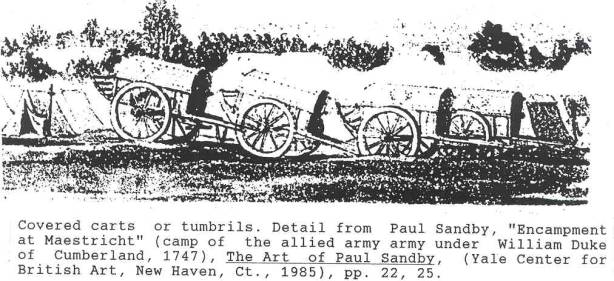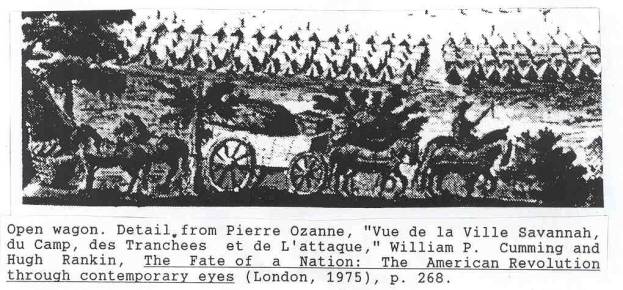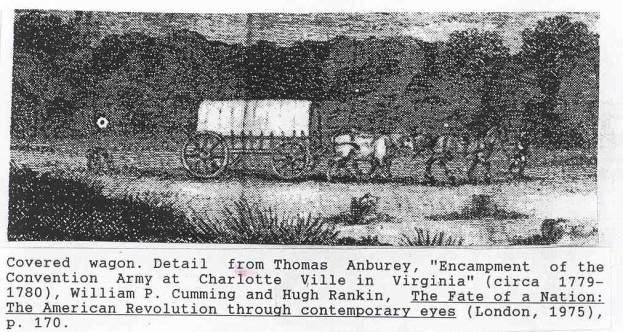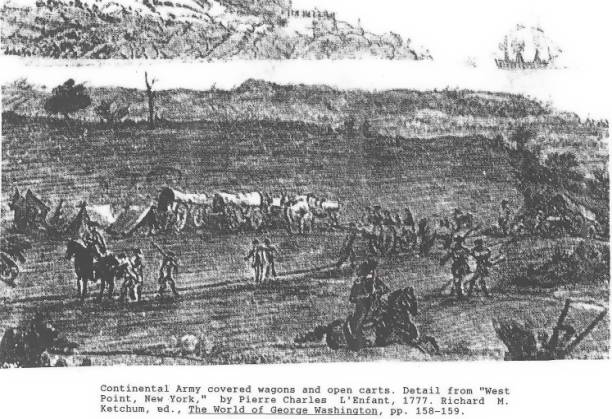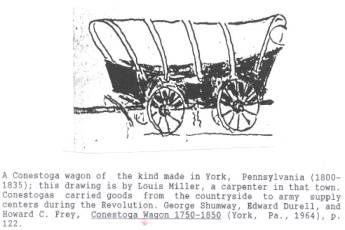by John U. Rees
Armies are comprised of soldiers, who need food in their bellies, clothing on their backs, and various items of equipment, from tents for sheltering the men to weapons for fighting. All these commodities had to be purchased, moved to a supply center (magazine), and on to wherever soldiers needed them. Forts had their own storehouses to receive goods, but a moving army had to carry food and equipment with them. Wagons and watercraft were integral throughout this process. The intent of this article is to present information gathered on both types of transport as used by Revolutionary armies. Though some specially-designed transport was contrived by the military (such as “Waggon Boats” in the American army, and the “English reduced” and “new” wagons in the British), of necessity both armies procured wagons and vessels from local civilians, or copied tried-and-true designs when building anew, giving us some interesting insights on civilian vessels and vehicles of the time.
Part I.
“Country Waggons,” “Tumbrils,” and “Philadelphia Carts”
Wheeled Transport in the Armies of the Revolution
Terrain and weather varied greatly in areas where military operations occurred and rudimentary road systems made transport of army supplies difficult at best. Wagons were the most important mode of transporting those supplies armies needed to carry with them, since waterways did not always follow the direction dictated by military necessity or were under enemy control.
First, an overview of the organization of wheeled transportation in the American army is in order. For much of the war all Continental Army wagons were procured by the Quartermaster’s Department, and served under supervision of the Wagonmaster General; these included vehicles carrying supplies to the army as well as those accompanying the troops. A Wagon Department, subordinate to the Quartermaster General, was created in 1777 to deal with the army’s increasingly complex transportation needs. The Wagonmaster General headed the department, with deputy wagonmasters general assigned to the main army and each regional military department. In the Northern Department alone the Deputy Wagonmaster General had five wagonmasters under his direction; they, in turn, each had charge of one or more wagon brigades and their drivers. As historian Erna Risch notes, “These officers received all horses, oxen, wagons, and carts that the Continental Army required, but they could neither purchase nor hire them without the express order of the Commander in Chief, the commanding officer of the military department, the Quartermaster General, or the deputy quartermaster general of a military department. The [1777] regulation establishing the Wagon Department remained in effect until 1780, when Congress drastically reorganized the Quartermaster’s Department following the adoption of the system of specific supplies” supplied by state governments. At the time of this reorganization the Wagon Department had eleven deputy wagonmasters general, one hundred and eight men specifically enlisted as wagonmasters, three soldiers serving as wagonmasters, two hundred fifty six enlisted wagoners, one hundred and four wagoners taken from among the soldiery, and two hundred seventy two hired wagoners.1
In 1775 wagons were hired by the Wagonmaster General to carry soldiers’ baggage and army equipment, as well as for other special needs. Eventually most baggage wagons and other military vehicles were made specifically for the army by private manufacturers or the Regiment of Artillery Artificers; hired civilian transport continued to be used until the war’s end for carrying materiel and provisions to the army from supply centers. When sufficient wagons could not be hired, the army impressed wheeled transport wherever it could be found. Thus, the wagons used by the armies during the war must have been remarkably diverse, both on the supply lines and, to a lesser degree, among the vehicles accompanying the troops. (For an excellent overview of wagons, transporting of supplies to the army, and all the difficulties encountered, see Erna Risch’s work Supplying Washington’s Army, pp. 64-90.)2
Large numbers and various types of vehicles were needed to support the Continental Army. A 1777 proposal allowed that “Five Teams [and wagons] are sufficient for a Regiment, one for the Field Officers and four to the Regiment. When the Regiment consists of not more than 5 or 600 Men … If 5 Teams to a Regiment should be thought unequal to the Wants the Waggon Brigades may be increas’d.” Commanders gained experience as the war progressed, and the transportation allotment was adjusted accordingly. An October 1780 “Estimate of Waggons” listed the “Total waggons for a regiment,” as four “4 horse close covered waggons,” one “2 horse close covered waggon or tumbril,” six “4 horse open waggons,” and one “2 horse open waggon or tumbril.” These vehicles were to serve three field officers, five regimental staff officers, twenty-seven company officers, and six hundred seventy-nine noncommissioned officers and privates. An earlier document included brigade support vehicles (one brigade was usually comprised of three or more regiments): one covered wagon was needed for the brigade quarter master and stores, four open wagons for the brigade commissary and provisions, two open wagons for the brigade forage master, two open wagons for the brigade commissary of military stores “for spare ammunition and arms,” one travelling forge, two field pieces, and two covered wagons for ammunition. A rather impressive array of transport.3
While horses were commonly used to pull wagons, in February 1781 Timothy Pickering “advised … ox teams for all but the artillery and cavalry, which, from the nature of their service would sometimes require greater expedition than oxen would be capable of.” This recommendation may have been implemented later, but for the rest of that year horses remained the preferred beasts of burden.4
Some problems with baggage were made evident by General Washington’s 22 August 1781 orders to Major General Benjamin Lincoln prior to his southward march during the Yorktown Campaign. Washington stated that Lincoln’s “Detachment … are to consider themselves as Light‑troops who are always supposed to be fit for action and free from every incumbrance” and advised them to divest themselves of “every article of Baggage which they can in any wise dispence with …” He went on to note the “great inconveniences [which] have arisen in the transportation of Baggage from officers commanding regiments procuring a greater number of waggons than is their proportion and from not having the Tents and Baggage of the officers conveyed in different Waggons from those that carry the Soldiers tents …” To rectify these problems it was directed that each regimental field officer would be allotted “one covered waggon,” “the regimental Staff Captains and Sub[altern]s: two covered and one open waggons,” and “To every hundred men one open Waggon.” Furthermore, “the commanding officers of regiments and corps to see that the tents and Baggage of the officers are convey’d in their proper Waggons and the Waggon Master General is directed to throw away any officers baggage that he finds loaded in those Waggons that are appropriated for the Soldiers Tents.”5
Part of the problem depended upon the type of wagon used. Four-horse open wagons and two-horse open tumbrils (two-wheeled carts) were available, but the preferred vehicle was a covered or “close” wagon pulled by four horses, or a covered two-horse tumbril, since covered vehicles kept stores dry and helped preserve them. (Covered wagons may have been topped by a high-standing cloth-covered frame or bonnet, while “close” wagons likely had a canvas cover which fit snugly over the vehicle’s load.) At the beginning of their march south in February 1781, “three close waggons” were allotted the Marquis de Lafayette’s light troops. These wagons were to hold “eleven horseman’s & 60 common tents.” Pickering informed General Washington that an officer would also “impress ten two horse waggons & have them at King’s ferry on the 20th to take up the baggage of the officers & the kettles of the men, as soon as they crossed [the Hudson River]. That number I judged sufficient, supposing the officers would take with them only their blankets, portmanteaus & cooking utensils …” These wagons would also carry an additional one hundred sixty tents to be picked up at Morristown, New Jersey.6
Late in the war special carts were built to hold Continental soldiers’ cooking utensils. In 1781 Quartermaster General Timothy Pickering recommended that ” The axes and camp kettles of each regiment are to be carried in a light two horse waggon by themselves.” He was more specific in a 14 January letter, calling for one “two horse open wagon or tumbril” to carry “116 camp kettles & 18 axes for the non com[missione]d. officers & privates.” At the same time the quartermaster general wrote Washington, “I mentioned the provision of carriages … for officers, & for … transporting the camp kettles of the troops. The two horse carts or tumbrils for both purposes may be constructed at Fishkill before the opening of the campaign,” and in an accompanying memorandum, “Major Cogswell & I (before the publication of the Genl. Order [directing that linen bags be made for carrying kettles]) had proposed having one two horse waggon so constructed as to carry the kettles of a whole regt.”7
Eventually Pickering described these vehicles, noting that “One two horse tumbril, about six feet in the body in length, with higher sides than usual (like a coal cart) will carry all the kettles of a regiment, with one small bowl to each, until our kettles can be made with covers.” George Washington’s “experiment” with kettle tumbrils seems to have borne fruit. In June Pickering directed a subordinate, “to set some of your artificers to repair the close covered waggons at Fishkill, doing those first which need fewest repairs. Great exertion will be necessary to get them done in time. The other workmen must proceed to complete the camp kettle waggons.” It must be noted that these carts were only intended as an adjunct to the usual way soldiers carried their utensils; in their hands or on their backs.8
In 1781 it was suggested that a single infantry regiment have three “4 horse close covered waggons,” one “2 horse canvas covered [wagon] for Camp Kettles,” and five “4 ox carts.” Timothy Pickering in February 1782 described the carts he would like used. “It will doubtless be necessary to purchase many carts (with yokes & chains) ready made; others probably you will have to get made new, the latter I should wish to have larger then [those] that were brought to the army last campaign, It would also be advantageous to make the sides as high as those of the pennsylvania waggons, which will render them much more useful & convenient for the carrying of baggage, for which most of them are designed. The precise dimensions I cannot give, having no cart with which to make a comparison, But let them be as light as shall be consistent with a due degree of strength & the rough service in which they are sometimes employed.”9
The “pennsylvania waggons” mentioned by Timothy Pickering were probably the well-known Conestoga wagons. This type of wagon was used as a long-distance carrier of supplies rather than for regimental baggage. Still, Timothy Pickering recognized that they had certain features, which would be useful on the army’s baggage wagons. Though Pickering did not know off-hand the dimensions of such vehicles, one example said to have been built in 1762 had a bed four feet deep by fourteen feet long. The Conestoga wagon and its antecedents saw widespread use in Pennsylvania as early as 1730, and many of the wagons supplied to General Braddock’s ill-fated 1755 expedition were of that type. In 1789 Dr. Benjamin Rush described the Conestoga as a “large strong wagon, covered with linen cloth … In this waggon, drawn by four or five horses … [farmers] convey to market over the roughest roads, two or three thousand pounds weight of … produce. In the months of September and October it is not uncommon to meet in one day from fifty to an hundred of these waggons on their way to Philadelphia, most of which belong to German farmers.” Similar sights must also have been common during the war.10
Francis Rush Clark, “Inspector and Superintendent of His Majesty’s Provision Train of Wagons and Horses,” wrote extensively on British transport problems in 1776 and 1777. “Nothing, but absolute necessity, can justify the hiring [of] Carriage for the Army, which must always be incompleat, & attended with considerably more expence, than having it the property of the Crown … The English Waggons, sent over for the use of the Army, were undoubtedly much heavyer, than was either necessary or proper. It furnish’d a plausible excuse for not useing them … [and] Orders were given, to hire Country Waggons in preference … Nothing of this sort could be constructed more unfit for an Army. They are so slight, as to be perpetually in want of repair. The Harness is made of slight leather & ropes, instead of Chains. These were taken promiscuously from the Farmers on Long Island & Staten Island, & some from the Jerseys. Many of them in a wretch’d Condition, & none having any Cover, to protect their Loading.”11
Clark executed drawings of several locally-built wagons used during the war. In addition to a simple two-wheeled “Philadelphia Cart,” he drew and described a “Philadelphia Waggon” (length 12 feet 3 inches; width, wheel to wheel – inside measurements – 6 feet 3 inches; height of sides, 10 inches), and the “Country Waggon from Long Island & New York” (length, 9 feet 10 inches; wagon body, front, 30 inches wide by 20 1/2 high; body rear, 41 inches wide by 34 inches high). Clark noted, “A great number of the Country Waggons … are put together in a most clumsy manner.”12
The last-named wagon is of particular interest. Francis Clark noted that the “Country Waggons” “generally used in this province [New York], are the sort introduced by the first Dutch Settlers, & the same now made use of in Holland.” He also wrote that “Many of these Waggons have straight Sides.” Clark’s drawing shows a vehicle with sloping concave side boards (called a “curved profile” by J. Geraint Jenkins, in his work The English Farm Wagon), similar to a Dutch wagon pictured in the late-16th century painting Siege of s’Hertogenboschby Van Hillegaert. While the profile of the late-18th century wagon is the same, the body of the earlier version “consists of a large number of wooden spindles running from a straight frame to a top-rail …
” Mr. Jenkins also notes that a “large number of sixteenth and seventeenth-century prints and drawings show exactly the same type of vehicle in Britain.”13
The “large English” wagon supplied to the British army was about the same size as the Philadelphia wagon though probably better suited to carry cumbersome loads. These wagons may have been similar to the ” Carrier’s wagon” commonly used in Great Britain during the period of the American Revolution. Like Clark’s “large English,” carrier’s wagons were noted to be of “great weight.” Both were likely of the type known as a box wagon, with large wheels, and able to carry heavy loads over rough road surfaces, though Superintendent Clark still deemed them unsuited for use in America.14Francis Clark also compiled a comparative listing of the different vehicles, which he included in his account:
| “The Weight of the Waggons of the Army.” | |
|---|---|
| [hundredweight] | |
| The large English | 13: 3: |
| The Philadelphia | 13: 3: 11 |
| & | 13: 2: _ |
| 7. _. _. | |
| The Dutch or American | 7. 2. _. |
| 8. _. _. | |
| 8. _. _. | |
| The English reduced | 8. 2. _. |
| A new Waggon with Rope Sides & | |
| Bottom, runs light & handy | 7. _. _. |
NB This Waggon has been greatly approved by all that have seen it, as the best & most fit for American Service.15
Superintendent Clark was intent on lessening the weight of wagons and enhancing their durability. One of his solutions was “The English reduced” wagon, a modification of the “large English.” He was ” Greatly distress’d at seeing the English Waggons & Stores, sent over at a considerable expence, remain unemployed … With this view, I had several of the Waggons reconstructed, by which means I reduced the Weight from thirteen hundred & a half, to Eight hundred & a half, This made them very little heavyer than the Country Waggons, & in every respect better & more compleat, besides the advantage of Covers, to protect the bread & baggage & screen the sick & Wounded.” A “new Waggon,” designed by Clark, was proposed for adoption by the British army. “The Body of this Waggon is 10 Feet long, & 3 Feet 6 Inches wide, The Sides are 18 Inches high, & turn down with hinges; a Box before, a hind Board framed light, to take off at pleasure, The Hind Wheels 4 Feet 8 Inches high, & the Fore Wheels 3 Feet 8 Inches high … This Waggon is made 4 Inches lower before than behind, which greatly facilitates the draught & light going, & the floor & Sides are made of Rope, spun of old Cordage, as few or no boards are to be purchased in these times; But if thought better, the floor & sides might be made with thin, light battins, flat hoops or twisted hay.” Not one to wait complacently while the new wagon was being considered, the Superintendent had “One of the English Waggons … alter’d & set up upon the same principle, & reduced in Weight from 1350 lb to 900 lb, & made up very serviceable, & with some still lighter.”16
Other methods of land transport were occasionally used by the American and British armies, including sleighs or sleds, and pack horses. These last were commonly called bat horses, from the French “bat” for ” packsaddle.”17
All in all, the wagons used to carry military supplies, and regimental and army baggage, began as a hodge-podge and probably remained so, ranging from sturdy, well-made vehicles, to “country waggons” and carts of varying quality. Given the needs of the armies, difficulties in procuring equipment, and the widespread and diverse areas where the campaigns occurred, standardization of transport was most likely never achieved.
- Erna Risch, Supplying Washington’s Army (Washington, D.C., 1981), pp. 66-71, 75.
- Ibid., pp. 69-70, 80-86.
- Proposed arrangement of the Quartermaster General’s Department, 1777, The Papers of the Continental Congress 1774‑1789, National Archives Microfilm Publications M247, (Washington, DC, 1958), reel 71, pp. 455-458 (henceforth cited as PCC, NA). “Estimate of Waggons for a regiment of infantry under the new establishment of Octr. 1780”, Timothy Pickering to George Washington, 14 January 1781, George Washington Papers, Presidential Papers Microfilm, (Washington, DC, 1961), series 4, reel 74 (henceforth cited as GW Papers). “Detail of Public Waggons, and those employd on hire for the Service of the Army … reckoned for an Army of 30,000 Infantry – 5 regimts. Cavalry & 5 of Artillery, ” 29 March 1780, PCC, NA, reel 41, p. 161.
- George Washington to Timothy Pickering, 10 February 1781, John C. Fitzpatrick, ed., The Writings of George Washington, vol. 21 (Washington. D.C., 1937), pp. 205-206 (henceforth cited as Fitzpatrick, WGW). . See also, Timothy Pickering to George Washington, 18 February 1781, GW Papers, Series 4, Reel 75.
- General orders, 22 August 1781, Fitzpatrick, WGW, vol. 23 (1937), pp. 37-38.
- “Estimate of Waggons for a regiment of infantry under the new establishment of Octr. 1780”, Timothy Pickering to George Washington, 14 January 1781, GW Papers, series 4, reel 74. Timothy Pickering to George Washington, 18 February 1781, ibid., series 4, reel 75.
- “Proposed distribution of waggons for the campaign 1781,” Numbered Record Books Concerning Military Operations and Service, Pay and Settlement Accounts, and Supplies in the War Department Collection of Revolutionary War Records, National Archives Microfilm Publication M853, Record Group 93 (Washington, D.C., 1973), vol. 103, reel 29, pp. 1-3 (henceforth cited as Nod. Record Books, NA). Timothy Pickering to Lt. Col. Dearborn, Col. Hatch and Ralph Pomeroy, Deputy Quarter Masters, 13 February 1782, ibid., reel 26, vol. 83, pp. 85-86.
- Pickering to Dearborn, Hatch and Pomeroy, 13 February 1782, ibid., reel 26, vol. 83, pp. 85-86. George Shumway, Edward Durell, and Howard C. Frey, Conestoga Wagon 1750-1850 (York, Pa., 1964), pp. 14-21, 35-37. John Omwake, The Conestoga Six-Horse Bell Teams of Eastern Pennsylvania (Cincinnati, Oh., 1930), pp. 32-33.
- “Narrative of Occurences, relative to His Majesty’s Provision Train in North America,” (circa 1778), Francis Rush Clark Papers (no. 2338), Sol Feinstone Collection, David Library of the American Revolution, Washington Crossing, Pa. (henceforth cited as “Narrative of Occurences,” Clark Papers, Feinstone Collection, PWacD).
- Colored drawings and descriptions of wagons in “Narrative of Occurences,” Clark Papers, Feinstone Collection, PWacD.
- “Narrative of Occurences,” and drawings and descriptions of wagons, Clark Papers, Feinstone Collection, PWacD. J. Geraint Jenkins, The English Farm Wagon (Wiltshire, U.K., 1972), pp. 9-13.
- Ibid., pp. 9-13.
- Colored drawings and descriptions of wagons, “Narrative of Occurences,” Clark Papers, Feinstone Collection, PWacD.
- Ibid.
- Timothy Pickering, “Proposed distribution of waggons for the campaign 1781, ” Nod. Record Books, NA, reel 29, target 4. “Estimate of Waggons for a regiment of infantry under the new establishment of Octr. 1780”, Timothy Pickering to George Washington, 14 January 1781, GW Papers, series 4, reel 74. Pickering to Washington (with enclosed memorandum), 14 January 1781, ibid., series 4, reel 74.
- Ibid.. Pickering to Major Keese, 18 June 1781, Nod. Record Books, NA, vol. 127, reel 26, 88.
- Richard M. Lederer, Jr., Colonial American English: A Glossary, (Essex, Ct, 1985). See also, John U. Rees, “‘We … got ourselves cleverly settled for the night …’: Soldiers’ Shelter on Campaign During the War for Independence,” part II, Military Collector & Historian, vol. 49, no. 4 (Winter 1997), p. 164, and, John U. Rees, “‘The great distress of the Army for want of Blankets …’: Supply Shortages, Suffering Soldiers, and a Secret Mission During the Hard Winter of 1780,” unpublished MSS, author’s collection (to be published in Military Collector & Historian).
